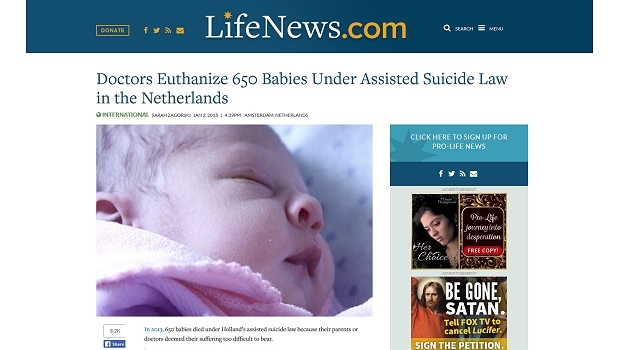Misinformation contagion about supposed 650 euthanized babies

Opponents of assisted dying have fallen prey to misinformation contagion about the Dutch Groningen Protocol, claiming that 650 babies would be or are euthanized every year. The claim is comprehensively and evidentially false.
Starting in 2013 and increasing in shrillness in 2015, numerous opponents of assisted dying law reform—many of whom are connected to conservative (Christian) sources—published online articles making false claims about the Dutch Groningen Protocol, wrongly claiming that up to 650 babies could be, would be or actually are ‘euthanized,’ ‘killed’ or ‘murdered’ every year under the Protocol’s provisions.
I provide a forensic analysis of the claim, demonstrating it to be comprehensively and evidentially false, in the latest edition of the Journal of Assisted Dying.
What is the Groningen Protocol?
- A national Dutch Regulation (not statute) effective since late 2006 whose current name is so long that it remains convenient to use its old name, ‘Groningen Protocol,’ even though it has changed.
- Permits, only as a last resort and with a number of strict conditions, the intentional ending of a newborn’s life when the newborn is in current (not merely anticipated) untreatable and unrelievable extremis.
- Mandatory reporting of intentionally hastened deaths to a national Commission and the Board of Prosecutors General at The Hague.
- Physician is not cleared until the case is deemed acceptable by the Commission and the Board and the Minister of Security and Justice.
- The Regulation is entirely separate from and unrelated to the Dutch Euthanasia Act for competent adults.
Where did the '650 babies euthanized' claim come from?
In 2013 the Royal Dutch Medical Association (KNMG) published a media release that launched a major policy paper about end-of-life decisions for neonates. The media release stated that of the approximately 175,000 births in the Netherlands each year, around 650 newborns will die as a result of severe congenital defects.
Some of these babies die soon after birth, in the delivery room. Others die later in neonatal intensive care despite the best interventions attempting to keep them alive. Yet others die after futile treatment is withdrawn and palliative (comfort) care is administered to minimize suffering prior to death.
Only in a tiny minority of cases is there a medical intervention with an explicit intention to hasten the death of the newborn, who is in untreatable and unrelievable extremis.
Despite this clarity, opponents—mostly linked to conservative religious sources—jumped on the misinformation bandwagon and trumpeted that 650 babies either could be or would be or are actually ‘euthanized,’ ‘killed’ or ‘murdered’ every year in the Netherlands.
What's the actual evidence?
- Neonatal euthanasia occurs around the world regardless of prohibition and is not caused by a protocol or regulation
- For example, the rate in France, with no regulation, is much higher than the Netherlands.
- Intentional hastening of neonatal death in the Netherlands is rare
- Most neonatal deaths occur either quickly with no medical intervention, or intensive treatment proves futile and palliative (comfort) care is administered until death.
- The (Groningen) Regulation has been further restricted since it was first formulated
- It has not been 'relaxed' as claimed by some opponents.
- The Regulation is separate from and completely unrelated to the Netherlands' Euthanasia Act
- The Euthanasia Act is only for mentally competent adults (and 12-16 year olds with parental agreement).
- Physicians do not receive black-letter law protection as they do under the Euthanasia Act
- Reporting, investigation and acceptance requirements are even more rigorous than under the Euthanasia Act.
- The rate of intention to hasten neonatal death has decreased since the Regulation came into effect
- In eight years prior to Regulation there were twenty two reported cases, and only two in eight years since Regulation.
- The rate of medical end-of-life decisions with an explicit intention to hasten death was 8–9% prior to Regulation, dropping to 1% after Regulation.
- The use of neuromuscular blockers has decreased.
- Physicians report improved communication with parents
- Shared decision-making and better opportunities for parents to grieve the loss of their child.
- There are clear explanations for the decrease in neonatal euthanasia in the Netherlands:
- Physicians report they are fearful of prosecution under the Regulation, so they now more often administer palliative care not intended to hasten death.
- A folate supplementation program for pregnant females has resulted in a substantial drop in the rate of spina bifida and related disorders.
- An antenatal screening program at 20 weeks has resulted in a higher rate of pregnancy terminations for major congenital disorders.
In conclusion
Despite all these facts, in an epidemic of 'confirmation bias' that drove misinformation contagion, many anti-euthanasia commentators have published false claims about '650 babies euthanized' under the Dutch Groningen Protocol. I provide a forensic examination of the issue in the latest edition of the Journal of Assisted Dying.
This is not the first example of how opponents of assisted dying widely circulate information that is untrue (e.g. check out the Council of Europe Declaration 1859 case), and it won't be the last. However, for opponents of assisted dying to avoid egg on face, I'd recommend:
Best not to engage in
misinformation contagion.

